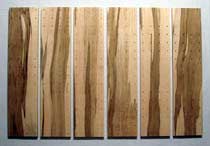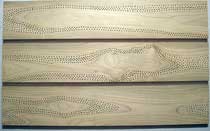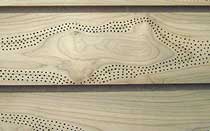
J.T. Kirkland runs “Thinking About Art” blog which has been covering art in the Washington D.C. area since June, 2004. The young Kentucky native and self-taught artist is having his first solo exhibit, “Studies in Organic Minimalism,” at University of Phoenix in Reston, Virginia, (through June 25).
I was interested in the work which combines minimalism and craftshop DIY-ism (the art is made of wood panels which Kirkland laboriously drills holes into to make simple organic patterns. (See his website for more images and info) I liked the loose gestures in the wood combined with a more pointy-headed formalism. I was also interested in the implied violence of the work (holes in wood made by drilling but evoking bullet holes)coupled with its calm organicity — a complex package masquerading as something simple. So I emailed Kirkland some questions and got some great, thoughtful answers. Turns out Kirkland is a wood visionary. Here’s part one of our Q&A. Part 2 and 3. (top image is “Expanse” and below is a detail of the same work)

RF. OK. So this is a get to know you warm-up question. Are you a sculptor?
JTK. I guess by most people’s definition I am a sculptor. However, I think of myself as a painter and drawer (is that even the proper word? Draftsman? I don’t know…). Though the materials I use and the techniques I leverage align somewhat with sculpting, I just haven’t gotten very comfortable with that notion. I’m much more comfortable with the idea of me being a painter or drawer. I’m not sure what that says about me.

RF. Where’d you go to school? Art school? Self-taught? Dad had a workshop you hung out in as a kid?
JTK. I attended Centre College in Danville, KY. It’s a very small liberal arts school with an enrollment of 1,000. I majored in Economics and took only one art class – Introduction to Glassblowing under Stephen Rolfe Powell. He opened my eyes to AbEx and Minimalism. Outside of one other community class I’m very much self-taught. While there are times I wish I had more formal training, I’m very happy with where I am today. I consider myself lucky to be where I am. (image is “Peninsula”)
My Dad is a huge woodworker and has made furniture almost his entire life. But as a child I hated being in the garage and it drove my Dad crazy. I didn’t like to be around the machines or to sand or anything else. I would have much rather played sports or video games. All of this makes it even more ironic that I ended up working with wood. And my Dad has been incredibly pleased by this as evidenced by me receiving some sort of power tool for the past few years of birthdays and Christmas’s. But without that background I wonder if I would have even thought of the power of wood in art. Like a lot of people who ignore wood, I bet I would never have recognized the beauty it holds.

RF. Is this body of work a continuation of an on-going theme or project or idea you’re interested in?
JTK. This body of work is definitely a continuation of a theme. That theme revolves around depth. I’m fascinated by the idea of real and perceived depth. Previously I was making abstract paintings on MDF. Prior to painting, I would drill some sort of hole pattern into the MDF. These were frequently just geometric shapes or line. Next, I would spray paint layers of color. A simple example would be a layer of light blue with a layer of gray on top. Once I have the drilled piece finished in terms of paint, I’d hand sand the piece with even strokes in a crossing pattern. After a while the various layers of color would appear so that you would see the light blue and the gray. The resulting composition would be quite random and who knows how it would work with the holes. I found this quite interesting. I liked the depth of color which was real and perceived, combined with the very real depth of the holes. I liked the idea of precise holes and random coloring. I liked the juxtaposition. (image above is “Shadow” and below is detail from the same work)

While I haven’t abandoned this mode of work I began to think of ways to achieve similar effects in a more mature and thought-provoking manner. I wondered why I was painting on wood. Why not use wood as painting? Suddenly my work became much more real. I was able to hone my interests in Minimalism and stripe paintings (you’ll see stripe paintings on my web site, and I own a few too). I’ve been profoundly impacted by the work of Agnes Martin and I think it’s easy to see her work in mine (i.e. grids, Minimalism and even to some extent stripes).









